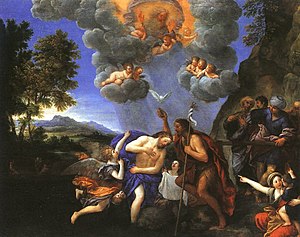Francesco Albani
Francesco Albani | |
|---|---|
 | |
| Born | 17 August 1578 |
| Died | 4 October 1660 (aged 82) Bologna |
| Nationality | Italian |
| Known for | Painting |
| Movement | Baroque |
Francesco Albani or Albano (17 March or 17 August 1578 – 4 October 1660) was an Italian Baroque painter of Albanian origin who was active in Bologna (1591–1600), Rome (1600–1609), Bologna (1609), Viterbo (1609–1610), Bologna (1610), Rome (1610–1617), Bologna (1618–1660), Mantova (1621–1622), Roma (1623–1625) and Florence (1633).
Early years in Bologna
Albani was born in
Mature work in Rome

In 1600, Albani moved to Rome to work on the fresco decoration of the gallery of the
Albani became one of Annibale's most prominent apprentices. Using Annibale's designs and assisted by Lanfranco and
In 1609, he completed the ceiling of a large hall with Fall of Phaeton and Council of the Gods for the
During 1612–14, Albani completed the Choir frescoes at the church of Santa Maria della Pace which had just been remodelled by Pietro da Cortona. In 1616 he painted ceiling frescoes of Apollo and the Seasons at Palazzo Verospi in Via del Corso for the cardinal Fabrizio Verospi.
In his later years, Albani developed a mutual, though respectful, rivalry with the more successful
Albani's best frescoes are those on mythological subjects. Among the best of his sacred subjects are a St Sebastian and an Assumption of the Virgin, both in the church of
Legacy
Albani never acquired the monumentality or tenebrism that was quaking the contemporary world of painters, and is often derided for his lyric, cherubim-filled sweetness, which often has not yet shaken the mannerist elegance. While Albani's thematic would have appealed to
Among his pupils were his brother
Major works
- See Chronological List of paintings by Francesco Albani
- Frescoes in Hall of Aeneas – Palazzo Fava, Bologna
- Frescoes in Oratory of San Colombano – Bologna
- Frescoes in Hall of Aeneas (1601–1602) – Palazzo Doria Pamphilj, Rome
- Frescoes for San Giacomo degli Spagnoli (1602–1607) – Museo del Prado and in National Art Museum of Catalonia
- Holy Family with Angels (1608–1610) – MFA, Boston
- Allegorical canvases of the seasons Spring, Summer, Fall and Winter (1616–1617) – Galleria Borghese, Rome
- Nativity of the Virgin (1598) – Pinacoteca, Museo Capitolino, Rome
- Baptism of Christ (c. 1620) – Oil on canvas, 428.5 x 224.5 cm, Pinacoteca Nazionale di Bologna
- Diana and Actaeon (1625–1630) – Oil on wood transferred to canvas, 74,5 x 99,5 cm, Gemäldegalerie, Dresden
- Four Elements (1628–1630) – Pinacoteca, Turin
- Holy Family with Angels (1630–1635) – Oil on canvas, 57 x 43 cm, Palazzo Pitti, Florence
- Self-Portrait (c. 1630) – Oil on canvas, 75 x 59.5 cm, Pinacoteca Nazionale di Bologna
- Venus Attended by Nymphs and Cupids (1633) –Oil on canvas, 114 x 171 cm, Prado, Madrid)[1]
- Annunciation (1633) – Church of San Bartolomeo, Bologna
- The Annunciation – Oil on copper, 62 x 47 cm, Hermitage, St. Petersburg[2]
- Madonna with Child in Glory with Sts. Jerome and Francis (c. 1640) – Oil on copper, 43.5 x 31.8 cm, Pinacoteca Nazionale di Bologna
- The Baptism of Christ (c. 1640) – Oil on canvas, 268 x 195 cm, Hermitage, St. Petersburg
- The Rape of Europa (c. 1640–1645) – Oil on canvas, 170 x 224 cm, Hermitage, St. Petersburg
- Annunciation (c. 1640-1645) – Oil on copper, 62 x 47 cm, Hermitage, St. Petersburg
- The Holy Women at Christ's Tomb (1640s–1650s) – Oil on canvas, 170 x 224 cm, Hermitage, St. Petersburg
- Danza degli amorini – Pinacoteca di Brera, Milan
- Tondo Borghese – Galleria Borghese, Rome
- Tasso's landscapes – Galleria Colonna, Rome
- Holy Family – Church of Madonna di Galliera, Bologna
Works owned by the Musée du Louvre
- Actaeon Changed into a Stag (c. 1630)
- Actaeon Changed into a Stag (c. 1617)
- Adonis Led by Cupids to Venus (1621–1633)
- Apollo and Daphne (c. 1615–1620)
- The Lamentation of Christ (c. 1601–1602)
- The Toilet of Venus (1621–1633)
- The Annunciation (c. 1620–1625)
- Christ Appearing to Mary Magdalene / Noli me tangere (c. 1620–1625)
- The Eternal Father and the Angel Gabriel (c. 1650–1660)
- Venus and Vulcan Resting (1621–1633)
- Nymphs Disarming Cupids (1621–1633)
- Saint Francis of Assisi Praying Before a Crucifix (c. 1630–1650)
- Salmacis and Hermaphroditus (c. 1630–1640)
- Venus and Adonis (c. 1630–1640)
- The Nativity (c. 1600), attributed
-
The Holy Family (Sacra Famiglia), 1630–35, oil on canvas, Galleria Pitti, Florence
-
Venus and Amor, oil on canvas
References
- Wittkower, Rudolf (1993). Art and Architecture Italy, 1600-1750. Penguin Books, Pelican History of Art. pp. 78–80, 82–83.
- This article incorporates text from a publication now in the public domain: Chisholm, Hugh, ed. (1911). "Albani, Francesco". Encyclopædia Britannica. Vol. 1 (11th ed.). Cambridge University Press. p. 481.
Notes
External links
![]() Media related to Francesco Albani at Wikimedia Commons
Media related to Francesco Albani at Wikimedia Commons
- Francesco Albani in the "History of Art"
- Francesco Albani Paintings Gallery Archived 2012-03-30 at the Wayback Machine (Public Domain Paintings - www.art.onilm.com)


